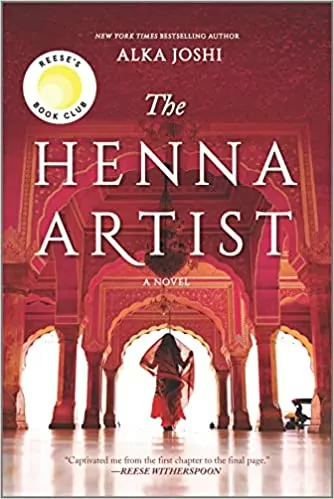Set against the vibrant backdrop of 1950s Jaipur, The Henna Artist by Alka Joshi narrates the tale of Lakshmi, a seventeen-year-old girl who escapes her abusive marriage in search of autonomy, self-identity, and a new beginning. Drawing on the complex interplay of gender, social class, and cultural norms, Joshi weaves a captivating story of resilience, struggle, and the transformative power of human connection.
Upon her arrival in Jaipur, Lakshmi’s artistic skills and intuitive nature enable her to carve a niche for herself as the most sought-after henna artist and confidante to the city’s upper-class women. However, the weight of her past remains an ever-present burden, as she must conceal her true identity and history to maintain her newfound status.
[Related: The Henna Artist Book Club Questions]
With keen insight into the intricate social dynamics of post-independence India, Joshi explores the precarious balance Lakshmi must maintain to avoid arousing the suspicion and jealousy of her gossipy clients and competitors, who could easily ruin her hard-earned reputation.
Lakshmi’s aspirations for an independent life are shaken when her estranged husband, Hari, reappears years later with a spirited young girl named Radha in tow, who is revealed to be her long-lost sister. This unexpected development challenges the protective barriers Lakshmi has carefully constructed, forcing her to confront unresolved emotions and the implications of her newfound responsibility towards Radha.
In spite of these challenges, Lakshmi’s unwavering determination and resourcefulness drive her to persevere. As she navigates the complex and often treacherous social terrain of Jaipur, she manages to uplift the lives of those around her, employing her artistic talents and sage counsel to empower her clients and loved ones. In doing so, she creates a delicate balance between personal ambition and social responsibility, as well as between tradition and modernity.
Throughout the novel, Joshi employs an academic style that engages the reader in a critical examination of the societal and cultural expectations placed upon Indian women during the mid-20th century. Through Lakshmi’s journey, the author highlights the significance of personal agency and the power of resilience in the face of adversity, offering a poignant and inspiring tale that transcends time and place.
In conclusion, The Henna Artist is a compelling exploration of one woman’s struggle for independence, identity, and self-determination amidst the constraints of a rigid social hierarchy. By blending rich cultural detail, vivid characterization, and a thought-provoking narrative, Alka Joshi has crafted a timeless tale that speaks to the universal human experiences of courage, sacrifice, and the unyielding pursuit of self-realization.
[Related:Summary of The 7 Husbands of Evelyn Hugo]
Main takeaways
Here are some of the key takeaways from the Henna Artist book:
1. Resilience and determination: The Henna Artist highlights the importance of resilience and determination in overcoming adversities and pursuing one’s dreams. Lakshmi’s journey from escaping her abusive marriage to establishing herself as a sought-after henna artist in Jaipur demonstrates the power of perseverance in the face of obstacles.
2. The complexity of social dynamics: The novel explores the intricate social dynamics in post-independence India, particularly the roles and expectations placed upon women. Through Lakshmi’s experiences and interactions, readers gain insight into the challenges women faced in balancing tradition, social norms, and personal aspirations.
3. The significance of personal agency: The Henna Artist underscores the importance of personal agency and self-determination in shaping one’s life. By taking control of her destiny, Lakshmi is able to break free from the constraints of her past and create a new life for herself and her sister.
4. The transformative power of human connection: Throughout the novel, the relationships that Lakshmi forms with her clients and loved ones prove to be integral to her growth and development. These connections not only support her in times of need, but also enable her to empower others in their own struggles.
5. Balancing ambition and responsibility: Lakshmi’s journey highlights the delicate balance between personal ambition and social responsibility. As she navigates the complexities of her newfound independence and social status, she learns the importance of uplifting others while staying true to her own dreams and aspirations.
6. Tradition versus modernity: The Henna Artist delves into the tensions between tradition and modernity in mid-20th century India. Through Lakshmi’s experiences, readers witness the challenges of reconciling cultural heritage with the desire for personal autonomy and progress.
7. The power of art and creativity: The novel celebrates the power of art and creativity in providing solace, expression, and a means of livelihood. Lakshmi’s henna designs serve not only as an artistic outlet but also as a way to connect with her clients and forge her own identity.
8. The importance of self-realization: Ultimately, The Henna Artist emphasizes the significance of self-realization and the pursuit of personal fulfillment. Through her journey, Lakshmi demonstrates the potential for growth, transformation, and empowerment that lies within each individual, transcending societal constraints and expectations.
I hope you find The Henna Artist book summary helpful!







